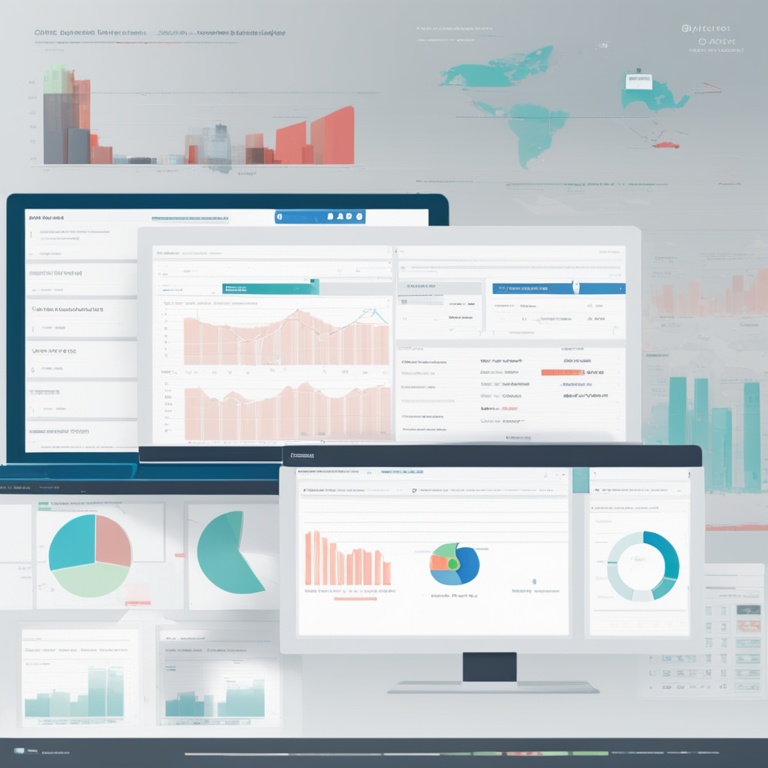

In today's fast-paced global business landscape, international operations are the cornerstone of success for many enterprises. However, with the complexity and scale that come with operating across different countries and regions, obtaining seamless insights into these operations can be a daunting task. This is where the power of automated reports and dashboards comes into play, revolutionizing the way we manage and understand our international endeavors.
The Challenges of International Operations without Automation
International operations involve a myriad of moving parts, from supply chain management across multiple locations to coordinating sales and marketing efforts in diverse cultural and economic settings. Without an efficient system for gathering and analyzing data, businesses often find themselves drowning in a sea of information, struggling to make sense of it all.
One of the primary challenges is the time-consuming nature of manual reporting. Teams across different international offices may be using various methods and formats to collect and report data. This not only leads to inconsistencies but also requires significant manpower to collate and analyze. By the time the reports are ready, the data may already be outdated, preventing timely decision-making that could impact the bottom line.
Another hurdle is the lack of a unified view. With operations spread globally, it's difficult to get a holistic understanding of how different aspects of the business are performing in relation to each other. For example, how does a change in production in one country affect sales in another? Without a comprehensive dashboard that can integrate data from various sources, these connections remain hidden, and opportunities for optimization are missed.
The Benefits of Automated Reports and Dashboards
Automated reports and dashboards offer a plethora of benefits that can transform the way international operations are managed.
First and foremost, they save time. By automating the data collection and reporting process, employees can focus on more value-added tasks rather than spending hours on mundane data entry and compilation. The system can pull data from multiple sources in real-time, ensuring that the reports and dashboards are always up-to-date. This enables managers to make informed decisions promptly, taking advantage of emerging opportunities or addressing potential issues before they escalate.
Secondly, they provide consistency and accuracy. Automated systems follow predefined rules and algorithms for data gathering and analysis, eliminating the human errors that often creep into manual reporting. This means that the insights generated are reliable, allowing for more confident decision-making. Whether it's financial data, sales figures, or supply chain metrics, having accurate and consistent information is crucial for understanding the true state of international operations.
Moreover, automated reports and dashboards offer a unified view. They can integrate data from different departments, locations, and systems, presenting a comprehensive picture of the entire international operation. This holistic perspective enables managers to identify trends, correlations, and patterns that would otherwise be overlooked. For instance, they can see how changes in exchange rates impact profitability across different markets or how marketing campaigns in one region influence customer acquisition in others. With this level of visibility, businesses can optimize their strategies and allocate resources more effectively.
How Automated Reports and Dashboards Work
At the heart of automated reports and dashboards is a sophisticated data integration and analytics engine. This engine is designed to connect with various data sources, such as enterprise resource planning (ERP) systems, customer relationship management (CRM) tools, and supply chain management software.
Once connected, the engine extracts the relevant data based on predefined criteria. For example, if we want to generate a report on international sales, the engine will pull data on sales volumes, revenue, customer demographics, and more from the CRM and ERP systems. It then cleans and transforms the data to ensure its quality and compatibility for analysis.
After the data is prepared, it is analyzed using advanced analytics techniques. This can include descriptive analytics to summarize the current state of affairs, predictive analytics to forecast future trends, and prescriptive analytics to recommend actions based on the analysis. The results of these analyses are then presented in the form of intuitive reports and visually appealing dashboards.
The reports can be customized to meet the specific needs of different stakeholders. For example, senior managers may require high-level summaries of key performance indicators (KPIs), while department heads may need more detailed reports on their specific areas of responsibility. The dashboards, on the other hand, offer an interactive and visual way to explore the data. Users can drill down into specific data points, filter by different criteria, and compare performance across different time periods or locations.
Implementing Automated Reports and Dashboards: Key Considerations
While the benefits of automated reports and dashboards are clear, implementing them successfully requires careful consideration of several factors.
Data Quality: The old adage "garbage in, garbage out" holds true when it comes to automated analytics. Ensure that the data sources are reliable and that the data is accurate, complete, and up-to-date. This may involve data cleansing and validation processes before integrating the data into the automated system.
Integration with Existing Systems: Most businesses already have a suite of existing software systems in place. The automated reports and dashboards need to integrate seamlessly with these systems to avoid disruptions and ensure smooth data flow. This requires a thorough understanding of the existing IT infrastructure and the ability to develop custom integrations if necessary.
User Training and Adoption: Even the most sophisticated automated system is useless if the users don't know how to use it. Provide comprehensive training to all relevant stakeholders, including managers, analysts, and front-line employees. Make sure they understand the benefits of the system, how to access and interpret the reports and dashboards, and how to use the interactive features effectively. Encourage user feedback to continuously improve the system's usability.
Scalability: As your international operations grow, the automated system should be able to scale accordingly. Consider future expansion plans when choosing an automated reporting and dashboard solution. Ensure that it can handle increasing volumes of data, more complex analytics requirements, and additional users without sacrificing performance.
Real-World Examples of Success
Let's take a look at some real-world examples of companies that have harnessed the power of automated reports and dashboards to streamline their international operations.
Company A, a global manufacturing firm, was struggling with coordinating its production and sales across multiple countries. Manual reports were taking too long to compile, and the data was often inconsistent. By implementing an automated reporting and dashboard system, they were able to pull real-time data from their ERP and CRM systems. The dashboards provided a unified view of production schedules, inventory levels, and sales forecasts. This allowed managers to make quick decisions on adjusting production levels based on sales trends, resulting in a significant reduction in inventory costs and an increase in customer satisfaction.
Company B, a multinational retailer, had difficulty understanding the impact of its marketing campaigns across different regions. With automated reports and dashboards, they could integrate data from their marketing automation software, CRM, and point-of-sale systems. The reports showed detailed analytics on customer acquisition, conversion rates, and sales by region. By analyzing this data, they were able to optimize their marketing strategies, targeting specific regions with more effective campaigns and increasing overall sales by 15% within a year.
These examples demonstrate the tangible benefits that automated reports and dashboards can bring to international operations. They not only improve efficiency and accuracy but also enable businesses to make more strategic decisions based on comprehensive insights.
Conclusion
In conclusion, streamlining international operations is no longer a luxury but a necessity in today's competitive global marketplace. Automated reports and dashboards offer a powerful solution to the challenges of obtaining seamless insights into these complex operations.
By saving time, providing consistency and accuracy, and offering a unified view, they empower businesses to make informed decisions promptly and optimize their strategies for maximum impact. While implementing such a system requires careful consideration of factors such as data quality, integration with existing systems, user training, and scalability, the rewards are well worth the effort.
As demonstrated by the real-world examples, companies that embrace automated reports and dashboards can achieve significant improvements in efficiency, cost savings, and overall business performance. So, if you're involved in international operations and want to stay ahead of the curve, it's time to consider implementing automated reports and dashboards for seamless insights.